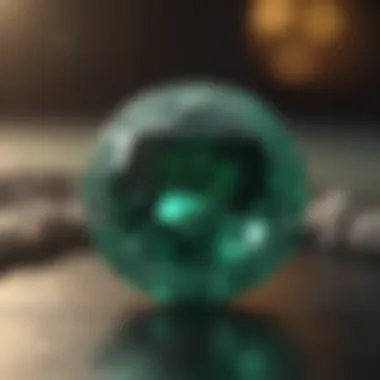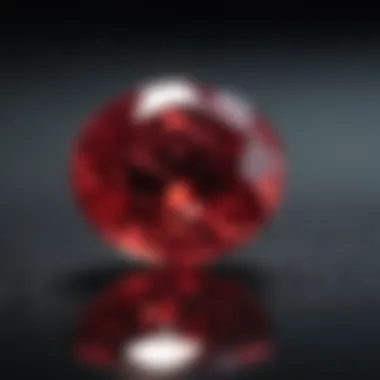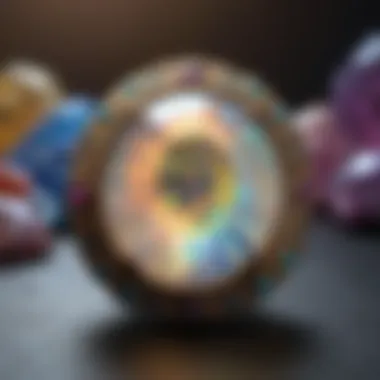Top Gemstones for Investment: A Comprehensive Guide


Overview of Gemstones and Minerals
Gemstones and minerals have a rich history throughout civilizations, serving varied purposes and holding significant cultural and societal meanings. These treasures of the earth have long captivated human interest, both for their stunning beauty and their perceived intrinsic value. From ancient talismans to modern luxury jewelry pieces, gemstones and minerals have played a pivotal role in shaping our history and traditions.
History of Gemstone and Mineral Use
Throughout history, gemstones and minerals have been prized for their beauty, rarity, and supposed mystical properties. Ancient civilizations believed in the protective and healing powers of gemstones, incorporating them into jewelry, tools, and even burial rituals. From the vibrant turquoise of the Egyptians to the mesmerizing rubies of the Far East, each culture has revered specific gemstones for their unique qualities and symbolism.
Significance in Culture and Society
The significance of gemstones in culture and society extends beyond mere aesthetics. Gemstones often symbolize status, power, and protection. They have been used as currency, traded for goods, and offered as gifts to forge alliances or express sentiments. Even today, gemstones play a crucial role in commemorating special occasions and milestones, symbolizing love, success, and endurance in various cultural contexts.
Gemstone Formation and Properties
Gemstones are formed through intricate geological processes that require specific conditions to create their dazzling beauty and durability. The formation process of gemstones involves a combination of heat, pressure, and mineral content over millions of years. These natural phenomena result in the unique properties that distinguish gemstones from other minerals.
Formation Process of Gemstones
The formation of gemstones typically begins deep within the Earth's crust, where intense heat and pressure transform basic elements and minerals into crystalline structures. Volcanic activity, tectonic movements, and even meteorite impacts contribute to the creation of gemstone deposits, each bearing the signature of its geological origins.
Properties that Define Gemstones
Gemstones possess specific properties that make them valuable to collectors and enthusiasts. Their hardness, color, clarity, and refractive index influence their overall quality and market value. The durability of gemstones, measured on the Mohs scale, determines their suitability for different types of jewelry and settings.
Classification based on Color, Hardness, and Luster
Gemstones are classified based on various criteria, including color, hardness, and luster. Color is one of the most defining features of a gemstone, with rare hues commanding higher prices in the market. Hardness, as measured by the ability to resist scratching, distinguishes durable gemstones like diamonds from softer varieties. Luster refers to the reflective quality of a gemstone's surface, enhancing its brilliance and appeal to connoisseurs.
Types of Gemstones
Gemstones come in a diverse array of varieties, ranging from the traditionally precious to the intriguingly exotic. Understanding the distinctions between different types of gemstones can help investors and collectors make informed decisions about their acquisitions, taking into account rarity, market demand, and historical significance.
Precious vs. Semi-Precious Gemstones


The traditional classification of gemstones into precious and semi-precious categories no longer captures the full spectrum of gemstone value and appeal. While diamonds, rubies, sapphires, and emeralds have long been considered precious, other gems like tourmaline, garnet, and amethyst exhibit beauty and properties that rival their more prestigious counterparts.
Common Gemstone Varieties
Among the common gemstone varieties found in jewelry and collector's circles, a few stand out for their popularity and versatility. Gems like aquamarine, topaz, citrine, and opal appeal to a wide range of tastes, offering unique colors, clarity, and affordability for different budgets and aesthetics.
Exotic and Rare Gemstones
For the discerning collector seeking unique and rare treasures, exotic gemstones present an exciting opportunity for investment and appreciation. Gems like alexandrite, tanzanite, and paraiba tourmaline possess remarkable color-changing properties and limited geographical sources, making them highly coveted and valuable in the gemstone market.
Identifying and Evaluating Gemstones
The value of a gemstone is not solely determined by its appearance but also by its intrinsic characteristics and market demand. Learning to identify and evaluate gemstones involves understanding the factors that influence their worth, using specialized techniques and tools to assess quality, and making informed decisions based on thorough research and expertise.
Factors Affecting Gemstone Value
Several factors contribute to the value of a gemstone, including its color intensity, clarity, cut precision, and carat weight. Rare colors or larger sizes often command higher prices, while flawless clarity and expert cuts enhance the gemstone's visual appeal and market desirability.
Techniques for Gemstone Identification
Gemologists and appraisers rely on a range of techniques to identify gemstones accurately, including magnification, spectrometry, and refractometry. These methods help determine a gemstone's mineral composition, origin, and treatment history, ensuring transparency and authenticity in the gem trade.
Assessing Gemstone Quality
Evaluating gemstone quality involves assessing its color saturation, transparency, and any inclusions or flaws that may impact its visual appeal and durability. Gemstone grading standards like those established by the GIA (Gemological Institute of America) provide a universal framework for comparing gemstones and setting quality benchmarks for buyers and sellers.
Caring for Gemstones
Proper care and maintenance are essential to preserve the beauty and value of gemstone jewelry and specimens. By following best practices for cleaning, storing, and safeguarding gemstones, collectors and enthusiasts can ensure their treasures retain their luster and durability for generations to come.
Cleaning and Storing Gemstones Properly
Different gemstones require specific cleaning methods to prevent damage or discoloration. From gentle soapy solutions to ultrasonic cleaners, knowing how to care for each gemstone type ensures longevity and brilliance in jewelry pieces. Storing gemstones away from direct sunlight and extreme temperatures helps maintain their stability and vibrancy over time.
Avoiding Common Mistakes in Gemstone Care


Common mistakes in gemstone care include exposure to harsh chemicals, abrasive substances, or sudden temperature changes. Avoiding contact with cosmetics, household cleaners, and rough surfaces preserves the integrity of gemstones and prevents unnecessary wear or deterioration.
Preservation Tips for Specific Gem Types
Certain gem types, such as pearls, emeralds, and opals, have specific care requirements due to their delicate nature or sensitivity to environmental factors. Consulting with experts or referencing reputable resources can offer valuable insights into preserving the beauty and longevity of these special gemstone varieties.
Introduction
As we embark on a journey into the realm of gemstone investments, it is crucial to understand the pivotal role these precious stones play in the world of finance and luxury. Gems, with their timeless allure and tangible value, have captivated human civilizations for centuries, transcending mere aesthetics to symbolize wealth, power, and elegance. In this article, we delve deep into the intricate world of gemstone investments, unraveling the mystique that surrounds these geological treasures.
Exploring gemstone investments is not just about acquiring beautiful gems; it is a strategic financial decision with the potential to yield significant returns. Investors are drawn to gemstones for their rarity, durability, and aesthetic appeal, making them coveted assets in a diversified portfolio. Understanding the factors that drive the value of gemstones is essential for any discerning investor looking to navigate this intricate market landscape.
In this article, we shed light on the factors influencing gemstone investment decisions, from the rarity and scarcity of gemstones to their durability and hardness. We analyze how color and clarity play a crucial role in determining the value of a gemstone, offering insights into the intricate world of gemstone grading and assessment. By delving into the top gemstones for investment, including diamonds, rubies, sapphires, emeralds, and alexandrite, we unravel the unique characteristics and qualities that make these gems desirable assets for astute investors.
Moreover, we explore lesser-known gems with untapped investment potential, such as Paraiba tourmaline, Tsavorite garnet, and spinel, shedding light on the underrated gems that deserve a place in a well-constructed investment portfolio. Lastly, we delve into the essentials of caring for gemstone investments, emphasizing the importance of proper storage, regular maintenance, certification, and appraisal in maximizing the value and longevity of gemstone assets.
Join us on this enlightening journey into the world of gemstone investments, where beauty meets financial acumen and luxury intertwines with strategic wealth preservation. Let's uncover the timeless allure and enduring value of gemstones as we navigate through the intricacies of this fascinating market landscape.
Color and Clarity
Color and clarity are critical factors that investors analyze when assessing the value of gemstones. The color of a gemstone, be it a deep red ruby or a vivid blue sapphire, contributes significantly to its allure and market desirability. Exceptional color saturation and uniformity are preferred qualities that enhance a gemstone's worth. Furthermore, clarity, which refers to the presence of internal flaws or inclusions, impacts the gemstone's visual appeal and overall value. Gemstones with high clarity levels and minimal imperfections are more valuable, appealing to discerning investors seeking premium quality stones for their investment portfolios.
Top Gemstones for Investment
Investing in gemstones can be a lucrative venture imbued with a sense of prestige and beauty. The allure lies not only in their aesthetic appeal but also in their potential for high returns. Choosing the right gemstones to invest in requires a keen understanding of various factors. From rarity and durability to color and clarity, each aspect plays a pivotal role in determining the value and desirability of a gemstone.
Diamonds
Diamonds have long been synonymous with wealth and luxury. Within the realm of diamond investment, different categories offer unique advantages. Natural colored diamonds, revered for their exquisite hues ranging from pink to blue, hold a special place in the hearts of collectors. Their rarity and the intensity of their color make them highly sought after. Large carat diamonds, on the other hand, command attention due to their sheer size and rarity. As the carat weight increases, the diamond's value surges exponentially. Investment-grade diamonds refer to stones that meet strict criteria in terms of color, clarity, and cut. These diamonds are certified and often serve as stable investments, with a potential for consistent appreciation over time.
Rubies
Roses renowned for their vibrant red hue, rubies are among the most coveted gemstones. Pigeon blood rubies, named after their deep red color reminiscent of a pigeon's blood, are highly prized in the world of gemstone investment. Their intense color saturation and minimal inclusion levels contribute to their exceptional value. Burmese rubies, originating from Myanmar, boast a unique fluorescence that sets them apart. Star rubies, distinguished by a phenomenon called asterism where a star-like pattern appears under light, are considered mystical and alluring.
Sapphires


Sapphires, known for their brilliant blue color, encompass a spectrum of hues that extend beyond blue. Kashmir sapphires, hailing from the mines of Kashmir, exhibit a velvety blue hue that is unmatched in its allure. Padparadscha sapphires, named after the lotus flower, combine pink and orange tones to create a rare and enchanting gemstone. Cornflower blue sapphires, characterized by their intense blue color reminiscent of a cornflower, symbolize loyalty and wisdom.
Emeralds
Emeralds, with their rich green hue, symbolize growth, renewal, and prosperity. Colombian emeralds, originating from Colombia's renowned mines, are celebrated for their vivid green color and exceptional clarity. Zambian emeralds, known for their deep green hue and excellent transparency, offer an attractive alternative for investors. Muzo emeralds, sourced from the historic Muzo mine in Colombia, boast a vibrant green color that captivates the eye.
Alexandrite
Alexandrite, a fascinating gemstone known for its color-changing properties, transitions from green in daylight to red under incandescent light. This rare phenomenon makes alexandrite a highly sought-after gem among collectors and enthusiasts. Its scarcity and unique optical qualities contribute to its investment potential, offering a blend of beauty and rarity in one captivating stone.
Lesser-Known Gems with Investment Potential
When delving into the realm of gemstone investment, it is imperative to not overlook the allure and potential of lesser-known gems. While diamonds, rubies, and sapphires dominate the market, venturing into lesser-known gemstones can present unique opportunities for astute investors. These gems, although not as mainstream, possess intrinsic qualities that can make them highly sought after by collectors and connoisseurs alike. Understanding the significance of exploring lesser-known gems with investment potential opens up a world of possibilities in diversifying one's gem portfolio.
Paraiba Tourmaline
Paraiba Tourmaline, named after the Brazilian state of Paraiba where it was first discovered, is a captivating gemstone renowned for its striking neon blue to green hues. This gemstone's rarity and unique coloration elevate its desirability among gem enthusiasts. Paraiba Tourmaline's vivid color is attributed to traces of copper in its crystal structure, leading to its characteristic luminosity. Gemstone connoisseurs often laud Paraiba Tourmaline for its exceptional clarity and brilliance, making it a prized addition to any collection. Despite its beauty, the limited supply of Paraiba Tourmaline contributes to its high value and allure in the market.
Tsavorite Garnet
Tsavorite Garnet, originating from East Africa's Tsavo National Park, is a vibrant green gemstone that captivates with its intense color and remarkable brilliance. This lesser-known gem stands out for its color saturation and exceptional clarity, making it a favored choice for jewelry designers seeking a unique and eye-catching gemstone. Tsavorite Garnet's durability and wearability also add to its appeal, ensuring long-lasting beauty in any jewelry piece. With a growing recognition among gemstone aficionados, Tsavorite Garnet offers a compelling investment opportunity for those looking to diversify their gem collection.
Spinel
Spinel, often overshadowed by other gemstones, possesses a distinctive charm that sets it apart in the world of colored gems. Known for its wide range of colors, including vibrant reds, blues, pinks, and purples, Spinel exudes elegance and versatility. This gemstone's brilliance and durability make it a favored choice for both collectors and jewelry enthusiasts seeking an alternative to traditional precious stones. Despite its lesser-known status, Spinel's affordability relative to other gemstones makes it an attractive option for investors looking to acquire valuable gems without the hefty price tag. Exploring the diverse hues and characteristics of Spinel unveils a world of possibilities for discerning individuals seeking unique and alluring gemstones for their investment portfolio.
Caring for Gemstone Investments
Gemstone investments require meticulous care to preserve their value and beauty. Caring for gemstones is a crucial aspect that should not be overlooked in any investment strategy. Proper maintenance can significantly impact the longevity and asset worth of your collection. Whether you are a seasoned gemstone enthusiast or a novice investor, understanding the importance of caring for your gemstones is paramount to safeguarding your investment for the future.
Proper Storage
Proper storage of gemstones is essential to prevent damage and preserve their quality. Gemstones should be stored in a cool, dry place away from direct sunlight and extreme temperatures. It is advisable to keep each gemstone in separate compartments or pouches to avoid scratching or chipping. Additionally, utilizing gem-safe materials such as soft velvet or felt-lined containers can help reduce friction and minimize the risk of abrasions. Implementing a systematic storage protocol not only protects the physical integrity of the gemstones but also simplifies organization and tracking of your collection.
Regular Maintenance
Regular maintenance routines are vital for the upkeep of gemstone investments. Cleaning gemstones with a gentle solution and a soft brush helps to remove dirt, oils, and residues that can dull their sparkle over time. Inspecting gemstones periodically for any signs of wear or damage enables early detection and timely repairs, preventing potential loss of value. Establishing a consistent maintenance schedule tailored to the specific characteristics of each gemstone in your collection is key to preserving their brilliance and allure.
Certification and Appraisal
Seeking professional certification and appraisal services is a strategic step in managing your gemstone investments. Certified gemologists can provide expert evaluations of your gemstones' quality, authenticity, and market value based on rigorous analysis and industry standards. Having certified documentation not only enhances the credibility and resale potential of your gemstones but also assures potential buyers of their genuine nature. Regular appraisals also help track the appreciation or depreciation of your gemstone portfolio, allowing informed decisions regarding future investments or divestments.







